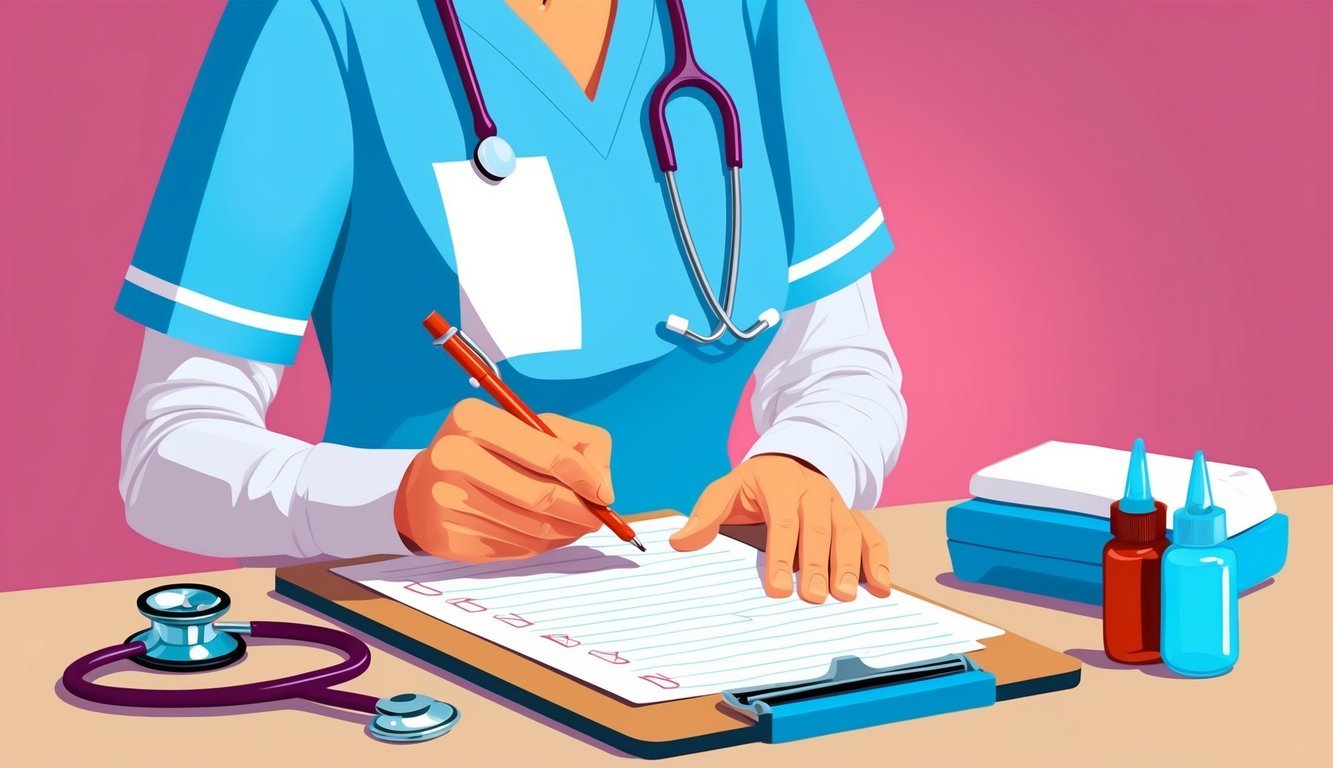Understanding the SOAP note framework is essential for effective nursing documentation. SOAP notes help you structure patient information systematically, making it easier to track progress and optimize care. Each part of the note—Subjective, Objective, Assessment, and Plan—provides valuable insights into patient needs and treatment strategies.
Crafting a thorough SOAP note can be challenging, but it is a vital skill in the nursing profession.
You will learn how to gather subjective patient information, document objective findings, analyze assessments, and outline a clear plan of action.
Mastering this format not only improves communication with colleagues but also enhances patient care.
As you dive into the examples and guidelines provided, you will find that utilizing SOAP notes can streamline your daily tasks and elevate your professional practice.
Key Takeaways
- Understand the structure of the SOAP note and its importance in nursing documentation.
- Learn how to effectively gather and document patient information.
- Improve patient care with a well-organized plan based on clear assessments.
The SOAP Note Framework
The SOAP note framework is a structured method for recording patient information in the medical field.
This method improves communication between healthcare professionals and ensures that all essential aspects of a patient’s visit are documented.
Understanding SOAP Format
The SOAP format stands for Subjective, Objective, Assessment, and Plan.
Each section serves a specific purpose in documenting patient interactions.
- Subjective includes the patient’s personal reports about their health. This can involve symptoms or feelings.
- Objective includes measurable data, such as vital signs, lab results, and physical examination findings.
- Assessment is the healthcare professional’s interpretation of the subjective and objective data. This section often includes a diagnosis.
- Plan outlines the next steps for treatment. This includes any further tests, medications, or referrals.
Using a clear SOAP note template helps streamline this process.
Components of a SOAP Note
When composing a SOAP note, ensure all components are thoroughly addressed.
Here’s a breakdown of each element:
| Component | Description |
|---|---|
| Subjective | Patient’s description of symptoms and concerns. |
| Objective | Observations and data collected during the examination. |
| Assessment | Analysis based on subjective and objective information. |
| Plan | Treatment plan including follow-up actions. |
In the Subjective section, write down what the patient says.
For Objective, list observed data like temperature or blood pressure.
Your Assessment should reflect your professional opinion, and the Plan should be actionable and clear for effective patient care.
Following this structured format promotes accurate documentation and improves healthcare communication.
For further examples and detailed guidance, you can refer to SOAP note examples.
Crafting the Subjective Section

Creating a strong subjective section in a SOAP note is crucial for establishing a clear understanding of the patient’s condition.
This part captures the patient’s personal experiences and insights, making accurate communication essential.
Gathering Subjective Data
Start by establishing a comfortable environment for the patient.
This encourages open conversation.
Use open-ended questions to allow the patient to express their thoughts freely.
Focus on gathering essential subjective data such as:
- Chief complaint
- Symptoms
- History of present illness
This information helps you create a detailed picture of the patient’s concerns.
For instance, asking, “Can you describe the pain you’re feeling?” provides more insight than a yes or no question.
Also, consider gathering relevant social history that may affect the patient’s health, such as lifestyle habits or stressors.
Documenting Patient Information and History
When documenting subjective information, be precise and thorough.
Note key details like:
- Patient demographics (age, sex)
- Medical history (previous conditions, surgeries)
- Family health history
Be sure to listen carefully and record direct quotes when appropriate.
This not only captures the patient’s voice but also emphasizes the importance of their feelings.
Use clear, specific language to avoid ambiguity.
For instance, writing “Patient reports sharp pain in the left knee, rated 7 out of 10” is more effective than vague descriptors.
This clarity aids in better assessment and planning of care.
For additional guidelines on SOAP notes, you can check out this step-by-step guide for medical professionals.
Constructing the Objective Section
The objective section of a SOAP note contains important, measurable data that supports clinical assessments.
In this part, you focus on physical findings, vital signs, and any relevant diagnostic tests.
Accurate documentation here enhances patient care and supports effective communication.
Recording Objective Data
When you record objective data, ensure it is clear and specific.
This includes all measurable observations, such as weight, temperature, and laboratory results.
Use standardized units for consistency.
For example:
| Data Type | Measurement |
|---|---|
| Temperature | 98.6°F (37°C) |
| Blood Pressure | 120/80 mmHg |
| Heart Rate | 75 bpm |
Avoid subjective language.
Instead of saying “The patient appears healthy,” say “Patient is well-nourished and appears in no acute distress.”
Including detailed findings helps in assessing the patient’s condition more accurately.
Vital Signs and Physical Examination
Vital signs are crucial for assessing a patient’s health status.
You should measure and document these at every visit.
Key vital signs include:
- Temperature
- Pulse
- Respiratory Rate
- Blood Pressure
In addition to vital signs, include findings from the physical examination.
Note any abnormalities observed during your assessment.
For instance:
- Skin Color: Pale
- Lung Sounds: Clear bilaterally
- Abdomen: Soft and non-tender
These objective findings provide essential data needed for diagnosis and treatment planning.
Using electronic health records (EHR) can enhance organization and accessibility for future assessments.
Consider using templates or forms within EHR systems to streamline data entry for your objective section.
This approach makes tracking changes over time easier and supports thorough patient care.
Analyzing the Assessment Section
The assessment section of a SOAP note is crucial for guiding patient care.
It involves synthesizing data to make informed diagnoses.
Understanding how to apply clinical reasoning and identify differential diagnoses enhances treatment plans and patient outcomes.
Clinical Reasoning in Diagnosis
In the assessment section, you use clinical reasoning to evaluate assessment data effectively.
This includes reviewing subjective and objective findings.
To do this well, consider the following steps:
- Gather Data: Review notes from the patient’s history and current symptoms.
- Interpret Symptoms: Analyze how symptoms align with known diseases. This can include factors like duration, severity, and triggers.
- Make Judgments: Use your clinical expertise to determine the most likely diagnoses based on the collected information.
A well-reasoned assessment helps healthcare providers focus on effective treatment plans.
Utilize evidence-based practices and guidelines during this phase to ensure accuracy.
Identifying Differential Diagnoses
Identifying differential diagnoses is essential to rule out other potential conditions.
You must consider various possibilities that might explain the patient’s symptoms.
Here’s how to approach this:
- List Possible Conditions: Create a table of potential diagnoses based on symptoms, including common and rare diseases.
- Prioritize Diagnoses: Rank them by likelihood. Factors like age, history, and risk factors can help in this task.
- Plan Further Evaluation: Decide which further tests or referrals are needed to confirm or rule out specific diagnoses.
By clearly identifying differential diagnoses, you can enhance your assessment accuracy.
This process also reassures patients of thorough evaluations.
You may find guidelines and support at Nursing SOAP Notes.
Developing the Plan Section

In this section, you will learn how to create an effective plan section in a SOAP note.
The focus will be on formulating a treatment plan and determining follow-up care to ensure the patient’s ongoing health and safety.
Formulating a Treatment Plan
Creating a treatment plan involves addressing the patient’s specific needs based on your assessment.
Start by outlining clear objectives, which can include goals like symptom relief or promoting recovery.
Key Components of a Treatment Plan:
-
Medications: Specify any prescriptions, dosages, and instructions for the patient. Ensure you’re clear about medication compliance to enhance effectiveness.
-
Patient Education: Provide guidance on managing symptoms and understanding the treatment process. This will empower the patient to take an active role in their recovery.
-
Referrals: If needed, recommend other healthcare professionals for specialized care.
Your plan should be documented in a clear and concise manner to facilitate communication among the care team and enhance patient progress.
Determining Follow-up Care
Follow-up care is essential for monitoring patient progress and adjusting the treatment plan as necessary.
You’ll want to establish specific follow-up appointments based on individual needs.
Important Aspects of Follow-up Care:
-
Follow-up Instructions: Give clear directions on what symptoms to monitor and when to seek medical advice. This can prevent complications and manage ongoing health concerns.
-
Appointment Scheduling: Schedule follow-up visits to ensure regular monitoring of the patient’s condition. This reinforces the importance of continued care.
-
Documentation: Keep detailed notes on each follow-up visit in the plan section. This will help you track changes in the patient’s condition over time.
Your structured approach will help ensure that the patient receives comprehensive care tailored to their unique situation.
Frequently Asked Questions
This section provides clear answers to common questions about writing SOAP notes in nursing.
You will find specific examples and tips to improve your note-taking skills.
How do you write a SOAP note in nursing?
To write a SOAP note, start by dividing it into four sections: Subjective, Objective, Assessment, and Plan.
- Subjective: Document what the patient reports, their feelings, and symptoms.
- Objective: Record measurable data from examinations, tests, and observations.
- Assessment: Provide a diagnosis or clinical judgment based on the data.
- Plan: Describe the next steps for treatment and follow-up.
For more detail, visit this guide on how to write a SOAP note.
What is an example of the objective part of a SOAP note?
The objective part of a SOAP note describes measurable and observable information.
For example, you might write:
- Vital signs: Blood pressure 120/80 mmHg.
- Physical exam findings: Lungs clear, no wheezing; abdomen soft with no tenderness.
Learn more about writing the objective section in your notes here.
What is an example of a SOAP note for pain?
Here’s a simple SOAP note example focusing on pain:
- S: The patient reports a pain level of 8/10 in the lower back. They mention that the pain worsens with movement.
- O: During the physical examination, we found tenderness in the lumbar region and observed no edema.
- A: We diagnosed the patient with acute low back pain. We believe it is likely due to muscle strain.
- P: We recommended ice application, prescribed NSAIDs, and scheduled a follow-up in one week.
You can find further examples of SOAP notes here.
What does a good SOAP note look like?
A good SOAP note is clear, concise, and accurate.
It should be easy to follow and contain the following traits:
- Organized structure
- Specific and detailed information
- Use of professional language
- No unnecessary jargon
For more tips on writing effective SOAP notes, check this article here.
Can you provide a SOAP note assessment example?
An assessment in a SOAP note reflects the nurse’s clinical judgment.
For instance:
- Assessment: We diagnosed the patient with acute bronchitis. We based this on the presenting symptoms and objective findings of wheezing on auscultation.
This section should combine both patient history and clinical observations.
For more assessment examples, see this detailed resource.
What components are included in a pediatric SOAP note by a nurse practitioner?
A pediatric SOAP note typically includes:
- Subjective: Child’s complaints and parent observations.
- Objective: Growth metrics, vaccination status, and physical exam findings.
- Assessment: Diagnosis considering developmental milestones.
- Plan: Recommendations for treatment and follow-ups tailored to pediatric care.
For guidelines specific to pediatric SOAP notes, visit this helpful site.

